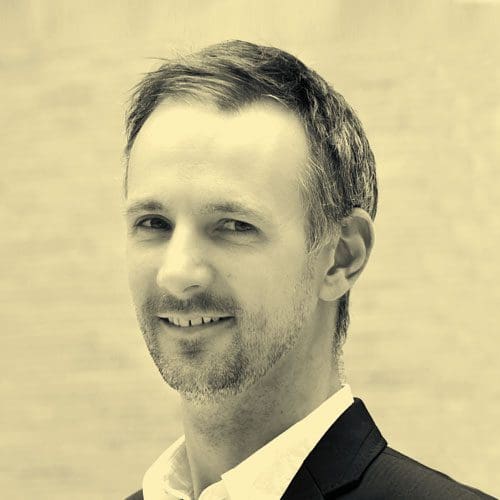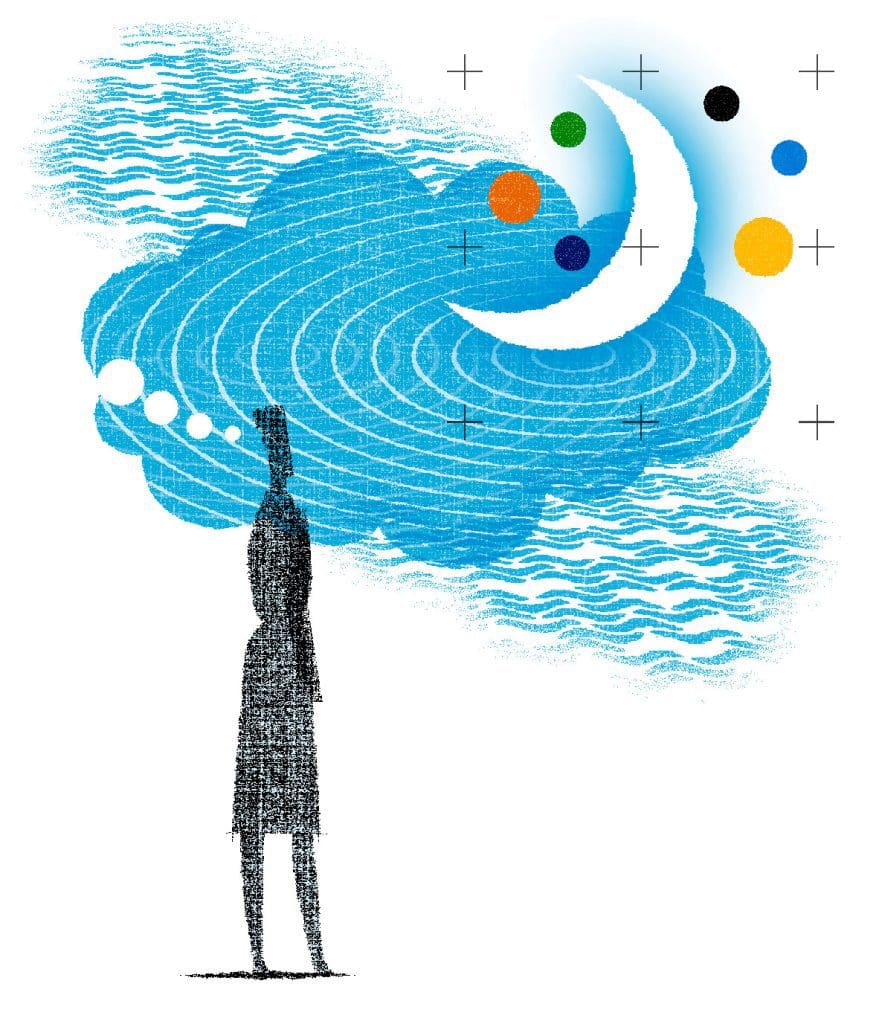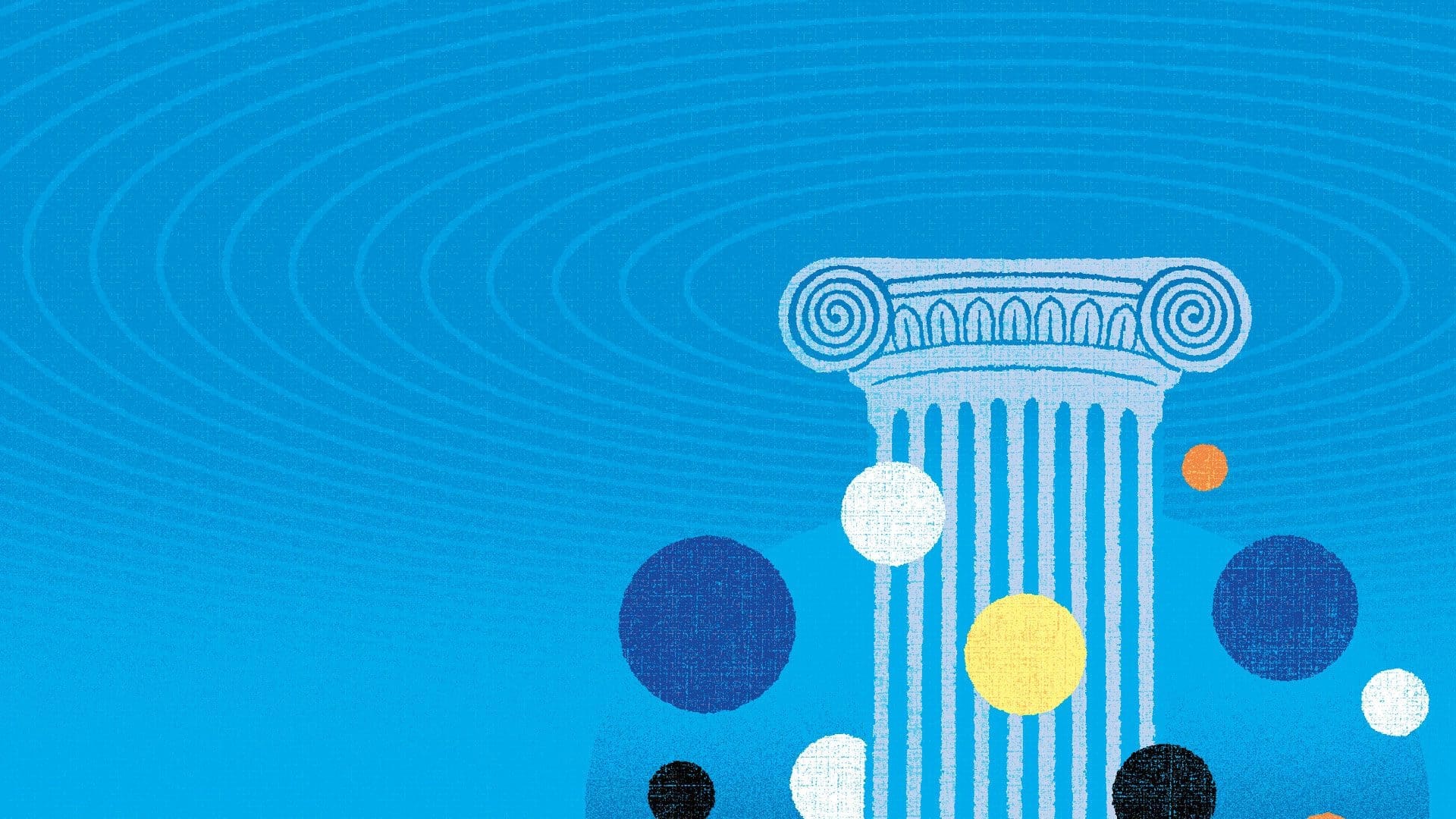
When Sean Carroll accepted an offer to become a Homewood Professor at Johns Hopkins University this past spring, the acclaimed physicist and public intellectual saw an opportunity.
“One of the benefits of [this professorship] is that you get to make your own title,” says Carroll. His books, podcasts, and videos bring the substance and the philosophical implications of contemporary physics to wider audiences. “And I thought of being boring about it, and just saying, ‘Homewood Professor of Physics and Philosophy.’”
But instead, Carroll threw down the gauntlet. He is Homewood Professor of Natural Philosophy. It’s a nod to potent connections between the natural sciences and philosophy that existed before the scientific revolution and the rise of the modern university.
“I thought this was an opportunity to both have some fun and to try to reclaim the intersection— and even the union—between these two different fields,” continues Carroll. “They were part of the same program hundreds of years ago, and they kind of still are. It’s just our academic desire to erect barriers and silos that has driven them apart.”
The Notion of a Divide
This notion of a profound and fundamental divide between the sciences and the humanities remains powerful. Even in our moment of burgeoning interdisciplinary collaboration. But such collaboration usually occurs within adjacent silos. Think biochemistry. Or cultural studies.
Yet Carroll’s gambit signals that a desire for dialogue across the divide never went away. And Johns Hopkins has become an essential stage for its renewal, attracting researchers actively engaged in bridging the chasm.
Ian Phillips, a Bloomberg Distinguished Professor of Philosophy and Brain Sciences, works to untangle mysteries of perception that connect philosophy and the mind/ brain sciences. “It does kind of help,” he says, “to have philosophers who know the science, and do some of the conceptual clarification in tandem with the scientists.”
Bloomberg professorships were established to encourage this active cross-disciplinary pollination in research and teaching. Phillips finds that “interdisciplinary engagement is an amazing opportunity to discover fresh puzzles. To find new ways of getting traction with really tricky issues.”
Broad and Useful Exchanges
Yet these renewed conversations yield more than joint appointments. Classics scholar and Andrew W. Mellon Professor in the Humanities Karen ní Mheallaigh says her study of the cross traffic between ancient texts and the sciences reflects broad and useful exchanges—both in the ancient world and now.
“The humanities are putting arrows in the quiver of scientists,” says ní Mheallaigh, who is chair of the Department of Classics. “And I think that works both ways. Scientists are opening up new worlds for us and giving us new material to chew on.”
She says her research suggests that “fiction offers us a playground for the mind” that is simultaneously the site of scientific advances. “Many of the great scientific breakthroughs,” she observes, “have occurred through slightly oblique—intuitive, if you like—leaps. The sort of leaps writers make as they play with language and imagine new worlds.”
Reclaiming Natural Philosophy
At the end of Act One of Hamlet, the Prince of Denmark converses with his vengeful father’s ghost. When his friend Horatio proclaims this event “wondrous strange,” Hamlet replies that “There are more things in heaven and earth, Horatio,/ Than are dreamt of in your philosophy.”
These words set out the limits of reason to interpret phenomena deemed strange, unknown, or even supernatural. Yet Shakespeare wrote Hamlet in 1600 or so—on the precipice of a revolution that would upend such sentiments. Scientists soon embarked upon a relentless pursuit of things “undreamt” through experiment and direct observation.
Yet as science grew in size, scope, and influence, fields embraced the rigor of the scientific method—or didn’t. Ties that once knit together a “natural philosophy” that held sway for centuries frayed—or snapped entirely.

There are plenty of philosophers who will go on about the fundamental nature of reality without taking physics into account… [but] the best philosophers of physics know an enormous amount of physics.”
—Sean Carroll
Physics and Philosophy
Sean Carroll’s work explicitly renews a deeper acquaintance between the sciences and philosophy. His academic career began with a PhD in astronomy from Harvard University. Then, a series of influential and highly cited papers in cosmology, and appointments at Caltech and the Santa Fe Institute. Yet Carroll has come to wider attention as a thinker who grapples publicly with the big ideas in contemporary physics. And brings clarity, rigor, and a keen sense of play to the task.
Books such as From Eternity to Here: The Quest for the Ultimate Theory of Time and The Big Picture: On the Origins of Life, Meaning, and the Universe Itself—as well as his popular weekly podcast, Mindscape—demonstrate Carroll’s skills as an explainer of the biggest and most confounding ideas in his field. Indeed, Carroll’s latest book, The Biggest Ideas in the Universe: Space, Time, and Motion, is the first in a trilogy of works that has evolved from a series of dazzlingly lucid videos that he made during the early months of the COVID-19 pandemic.
Yet a thread that runs through Carroll’s work is how the extraordinary discoveries of the past 150 years in physics should awaken us to the profound philosophical implications they possess.
In The Big Picture, Carroll says, “I tried to ask: ‘What really are the implications of these scientific ideas for our lives as human beings?’” He observes that “even the most recondite studies in physics and philosophy about metaphysics and quantum cosmology, and the fundamental nature of reality, do have implications for our place as human beings here in the universe. How could they not?”
The different tempos of scientific discovery and philosophical inquiry offer gateways for an exchange of ideas. Carroll observes that many areas in physics have made rapid progress, even in the time he has been in academia. “We didn’t have any exoplanets when I was a graduate student,” he observes. “And now we have thousands of them. That’s amazing.”
Give and Take Between Disciplines
But philosophy can help science where it is lagging. “There are other areas where we’re more stuck,” he continues. “Where the progress is not quite so rapid. And those are exactly the areas where sitting down and thinking carefully and examining your presuppositions can be very useful. Guess who’s really good at that? Philosophers.”
This bridge should carry vigorous two-way traffic, however. “There are plenty of philosophers who will go on about the fundamental nature of reality without taking physics into account… [but] the best philosophers of physics know an enormous amount of physics,” says Carroll. “There’s just no question that there’s room for a fruitful dialogue between physicists and philosophers in the right spirit.”
Carroll is already embracing the practical opportunities to walk the talk of natural philosophy as Homewood Professor. This semester, he is teaching classes in both the physics and philosophy departments. That includes a First-Year Seminar exploring his latest long-term topic of interest: the relationship between physics and democracy.
“I’m still very much learning about it myself. So I’m taking this as an opportunity to use the poor students as guinea pigs,” quips Carroll. “But there’s something special about getting around a table with a small number of people and discussing things. That’s the pinnacle of intellectual enjoyment for me. And I hope for them, too.” He adds, “My attitude is always: it’s us against the material. It’s not students versus me. It’s us trying to dig into it together.”
Vision Quest

Conversations between the humanities and natural sciences start on both sides of the divide. Acclaimed philosopher Ian Phillips’ work on perception is conducted on frontiers where the science of vision intersects with questions about consciousness.
His adroitness in conducting research that combines philosophy and psychology has resulted in numerous awards. Those awards include a 2021 Phi Beta Kappa Society and APA Lebowitz Prize for philosophical achievement and contribution (with philosopher Ned Block) and the 2017 Philip Leverhulme Prize. So it’s no surprise that Phillips is a firm believer in the power of interdisciplinary work to advance the field.
“There certainly has been a tendency in philosophy to hive itself off from science,” Phillips says. Or, in some cases, “to engage with science and other disciplines, by seeing them as opportunities to find conceptual confusion and wag fingers.” But when philosophers explore language or the mind, he asks, “Aren’t you interested in what linguists or psychologists have to say?”
Blindsight and Consciousness
The phenomenon of blindsight is at the center of Phillips’ recent work. Patients with blindsight report a complete lack of visual experience due to damage to their primary visual cortex. Yet they can still respond to visual stimuli beyond the possibility of mere chance under certain circumstances.
Scientists have labored to understand blindsight’s mechanics, but Phillips says it raises significant questions for philosophers as well. “Blindsight is such a major phenomenon for someone who’s interested in consciousness,” he says.
Phillips’ interpretation of the science— expressed in numerous papers and in other forums—is that blindsight is not a product of the unconscious mind, but, rather, a “severely and qualitatively degraded but nonetheless conscious vision.”
His interest in consciousness—and blindsight’s role in unlocking its mysteries—began as an undergraduate. He had read philosopher Daniel Dennett’s book Consciousness Explained. “It’s one of those gripping books that blends science and philosophy,” he says. “It includes a very interesting discussion of blindsight. But mostly philosophers have simply taken blindsight as a case that blows out of the water any claim that you must be conscious if you’re perceiving.”

There’s no point in talking to scientists if you don’t actually know what they’re doing. You’ve got to go to conferences. You’ve got to spend time in the lab. You’ve got to learn and appreciate the questions and culture they’re involved in.”
—Ian Phillips
Bits of Science
A quest to “teach myself bits of science” to advance his interest led Phillips to a seminar at Oxford University run by Paul Azzopardi. Azzopardi is an expert in perception and psychophysics who had done pioneering work on blindsight. “He introduced me to the basics of signal detection theory,” says Phillips, “which is a powerful framework I’d never come across before. I think it’s super philosophically helpful.”
Phillips’ research is grounded in his ready familiarity with the science of perception and consciousness. “The thing I find most important is that you’ve got to put in the time,” he says. “There’s no point in talking to scientists if you don’t actually know what they’re doing. You’ve got to go to conferences. You’ve got to spend time in the lab. You’ve got to learn and appreciate the questions and culture they’re involved in.”
As a professor in the departments of Philosophy and Psychological and Brain Sciences, Phillips is using that perch to collaborate with colleagues in the sciences. Most notably with Chaz Firestone, assistant professor and director of the Hopkins Perception and Mind Lab. He observes that “the psychological and brain sciences department, as well as the cognitive science department right next door, are filled with amazing, intellectually engaged, and open people. Quite a few of them actually have some kind of training in philosophy.”
Continuing to Focus on Philosophical Questions
Yet Phillips remains committed to bring insights gleaned from his work in the sciences back to larger philosophical questions. A piece that Phillips has co-authored with Craig French, an associate professor of philosophy at Nottingham University, for the forthcoming collection Contemporary Debates in the Philosophy of Mind, illustrates how he is doing this work.
Phillips and French grapple with philosophers’ rejection of Naïve Realism—a school of thought that posits the existence of a material universe of objects, and the notion that perception constitutively involves these objects’ existence independent of the mind.
Phillips says their contribution to the collection “discusses a wide range of people who have looked at the science and said: ‘The science is inconsistent with what Naïve Realists have been claiming about perception.’”

Lunar Landscapes
Human beings have gazed up at the moon for hundreds of thousands of years. Yet only in the past few centuries have humans possessed the scientific knowledge to better understand the moon—and even set foot on its surface.
Yet Karen ní Mheallaigh’s work on how humans observed and theorized about the moon—especially in ancient Greece and Rome— reveals an essential and continuing interplay between science and fiction. In The Moon in the Greek and Roman Imagination, she examines how the moon became “a kind of an imaginative space” for ancient thinkers of all sorts.
“The moon is a real place. We can see it. It’s there,” ní Mheallaigh says. “But it’s also a place the ancient Greeks couldn’t go. So they had to construct it out of their imagination—out of a mixture of observation, philosophical speculation, mathematical astronomy, and literary fantasy. So it’s a very conceptual world—and it seemed to me a really interesting stage for the crisscrossing of the scientific and imaginary. They were asking questions such as: What is the moon made of? What is it for—what role does it play in the cosmos? And what, or who, might live there?”
Ní Mheallaigh’s earlier work on the Roman author Lucian (including her first book, Reading Fiction with Lucian: Fakes, Freaks and Hyperreality) was a pathway into her lunar research. Not only did Lucian write two of the most famous ancient and influential narratives about lunar travel, but he also “draws constantly on the world of philosophical literature to help think about the nature of fiction itself.”

The moon is a real place. We can see it.… But it’s also a place the ancient Greeks couldn’t go. So they had to construct it out of their imagination— out of a mixture of observation, philosophical speculation, mathematical astronomy, and literary fantasy.”
—Karen ní Mheallaigh
Ancient Authors and Science
Investigating how ancient authors imagined the moon required immersion in the science of the era. Ní Mheallaigh discovered that pre-Socratic philosophers of the 6th and 5th centuries BCE also were fascinated by the moon. And, their studies were a “really important influence on the shape of early scientific thought” about the celestial body.
As she examined philosophical/scientific approaches in that era alongside literary ones, ní Mheallaigh found “they were more entangled than I had expected…. The ancient literary imagination latched on to some of the scientific and philosophical ideas, cannibalizing them and converting them into material for creating new imaginary worlds. Science was essentially feeding the literary imagination.” Yet storytelling and metaphor also infused the way that “the earliest scientific thinkers… made sense of the cosmos and expressed those ideas.”
Ní Mheallaigh’s lunar investigations have also tugged her interest into the ocean’s depths. In a Nautilus Project on the ancient submarine world undertaken with Emily Kneebone, classics professor at the University of Nottingham, she hopes to uncover more ways that science and literature come into confluence in classical texts.
“There are all kinds of analogies between the sky and the ocean pervading ancient thought,” explains ní Mheallaigh. “There is a famous passage in Plutarch’s essay On the Face in the Moon where he says: ‘If we were to look at the ocean without actually exploring it, we would assume that nothing can live in there…. There’s no air, there’s very little light, it’s cold. And yet we know that the ocean is absolutely teeming with life.’ So, Plutarch reasons, the same must hold true for other alien environments, such as the moon.”
Metaphors for our World
The scientific revolution may have answered many questions ancient thinkers had about the observed world. But as contemporary science pursues a seemingly inexhaustible supply of new queries, ní Mheallaigh believes that examining the history of classical thought’s encounters with science reveals how the persistence and power of the metaphor and other literary devices grapple with cosmological concepts along a continuum.
Ní Mheallaigh points to one of the earliest cosmological texts—Hesiod’s poem “Theogony”—as a case in point. While Hesiod deploys gods and myths in his explanations of the universe, he also grapples with its beginnings as a “chasm” or “chaos”—anticipating the questions that scientists have about the deepest remaining mysteries of the universe.
“There are similar metaphors at play,” ní Mheallaigh says, “similar language that we use to conceptualize these very strange phenomena. And similar thought processes. One speculative, and one calculated, reasoned, and—now at the dawn of the Webb era—increasingly documented. The comparative approach sheds light on—and deepens—our understanding of contemporary science. It shows that, actually, scientific thought is always engaged with its past as well as its contemporary world.”



